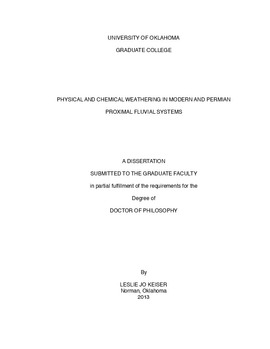| dc.contributor.advisor | Soreghan, Gerilyn S | |
| dc.creator | Keiser, Leslie Jo | |
| dc.date.accessioned | 2019-04-27T21:28:42Z | |
| dc.date.available | 2019-04-27T21:28:42Z | |
| dc.date.issued | 2013 | |
| dc.identifier | 99219485002042 | |
| dc.identifier.uri | https://hdl.handle.net/11244/318777 | |
| dc.description.abstract | Inferring paleoclimate from ancient fluvial strata can be challenging, | |
| dc.description.abstract | and conflicting interpretations for a given system are common in the literature. This research uses a combination of physical and chemical weatheringsignals in an attempt to better define the paleoclimatic interpretations for the proximal Cutler Formation near Gateway, Colorado (Chapter 3) and the Post Oak Conglomerate in the Wichita Mountains, Oklahoma (Chapter 4), both Permian units. Chapter 4 includes a comparison of weathering signals from modern sediments in the Wichita Mountains. A methodology for pretreatment techniques used for grain-size analysis was evaluated during the course of the research and is the topic of Chapter 2. This dissertation is organized as three stand-alone manuscripts and a brief summary of each is presented below. | |
| dc.description.abstract | Chapter 2 | |
| dc.description.abstract | Pretreatment drying of mud-sized sediment (<63 ìm) resulted in clayrich | |
| dc.description.abstract | (>39%) samples exhibiting more sensitivity to drying techniques than | |
| dc.description.abstract | clay-poor (<39%) samples. This demonstrates an influence of the drying | |
| dc.description.abstract | technique on the granulometric results. Employing freeze drying for sample drying yielded the most consistent results. However, for samples with <39% clay-sized material, all drying techniques are equally effective, and no apparent need exists for the extra effort (and expense) that accompanies freeze drying. | |
| dc.description.abstract | Chapter 3 | |
| dc.description.abstract | Scanning Electron Microscopy is a useful tool in the study of quartz | |
| dc.description.abstract | grain microtextures. Microtextures on quartz grains from the proximal Cutler Formation near Gateway, CO were documented for the presence/absence of 18 distinct microtextures. Averaging of presence/absence data for the samples provided a means to use more quantitative techniques than previously employed for SEM microtextural analysis. These continuous quantitative variables were utilized for non-metric multidimensional scaling, a purely quantitative technique that does not rely on initial assumptions of what environments produce specific microtextures. | |
| dc.description.abstract | Chapter 4 | |
| dc.description.abstract | The Post Oak Conglomerate was deposited in a climate much wetter | |
| dc.description.abstract | than the modern climate of the Wichita Mountains today. Significant amounts of clay, high percentages of Al2O3 in the mud fraction, spheroidal weathering, thick weathering rinds, and hyperconcentrated flood flow deposits are prominent in the Post Oak conglomerate and lacking in the modern Blue Beaver Creek sediment. When compared to other modern climates, the Post Oak Conglomerate fits best with a tropical climate. The climate of the region for the Early Permian is commonly interpreted to be arid. However; these results suggest a brief time period of wet conditions in the Wichita Mountains prior to the onset of the aridity documented in younger Permian units of the area. | |
| dc.format.extent | 155 pages | |
| dc.format.medium | application.pdf | |
| dc.language | en_US | |
| dc.relation.requires | Adobe Acrobat Reader | |
| dc.subject | Paleoclimatology | |
| dc.subject | Freeze-drying | |
| dc.subject | Sediments (Geology) | |
| dc.subject | Quartz--Cutler Formation | |
| dc.subject | Sedimentation and deposition--Oklahoma--Wichita Mountains | |
| dc.title | Physical and chemical weathering in modern and ancient proximal fluvial systems | |
| dc.type | text | |
| dc.type | document | |
| dc.thesis.degree | Ph.D. | |
| ou.group | Mewbourne College of Earth and Energy::ConocoPhillips School of Geology and Geophysics | |
